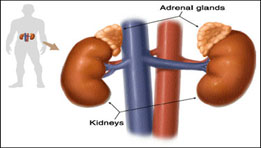What is an adrenal adenoma?
An adrenal adenoma normally is a non-cancerous tumor found on the adrenal gland. There are a total of two adrenal glands with each located directly above each kidney. The adrenal glands produce hormones that instruct nearly every organ and tissue in your body. Normally an adrenal adenoma is located in only one adrenal gland, but may be present in both. An adrenal adenoma is either categorized as nonfunctioning or functioning.

What causes an adrenal adenoma?
The cause of adrenal tumors is unknown. No particular risk factors have been noted on people who get adrenal adenomas.
Does this mean I have cancer?
Adrenal tumors are rarely cancerous. They are normally found incidentally on imaging scans that are being performed for other reasons. The radiologist (doctor who reads your imaging scans) measures the adrenal tumor by using Hounsfield units (HU) with a 95-99% degree of accuracy. If the adrenal tumor measures less than 10 HU then you have an adrenal adenoma. If the adrenal tumor measures more than 10 HU, then further testing needs to be conducted to determine whether the tumor is an adrenal adenoma or cancerous. Depending on the appearance and size, additional testing may be needed.
What happens next?
You might need medications or surgery to remove the adrenal gland that the tumor is in. If the adrenal adenoma is non functional, it is often watched. Your doctor may order a computed tomography (CT) scan or magnetic resonance imaging (MRI) scan approximately 6-12 months later to see if the tumor has grown. If it has grown or continues to grow, then the adrenal adenoma may need to be removed. If the adrenal adenoma is not growing, then your doctor will continue to monitor your hormone levels. If the adrenal adenoma remains small and continues to be non functional, no treatment may be warranted.
Who do I contact with any additional questions?
You can contact your family doctor who referred you for the screening.

